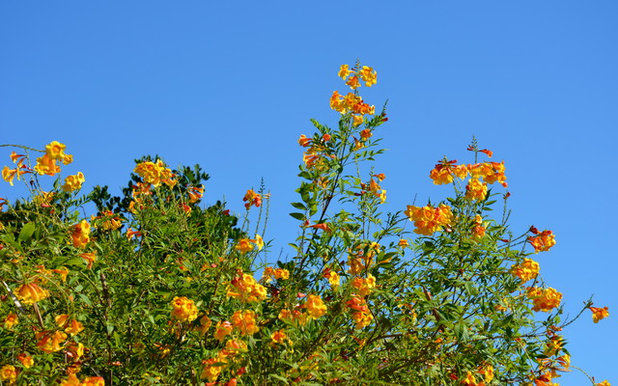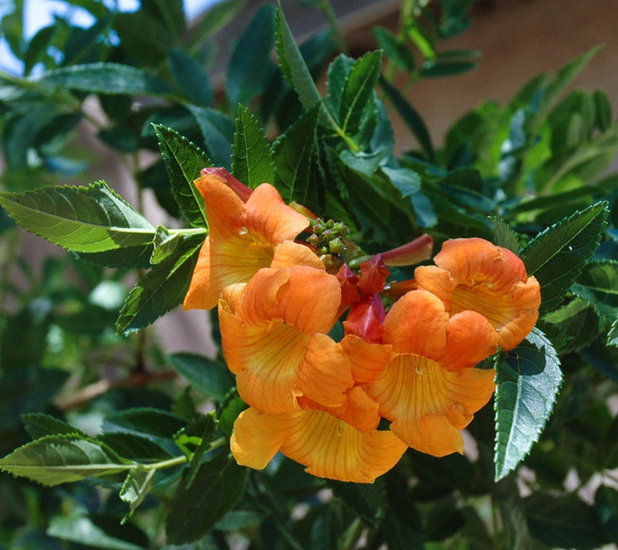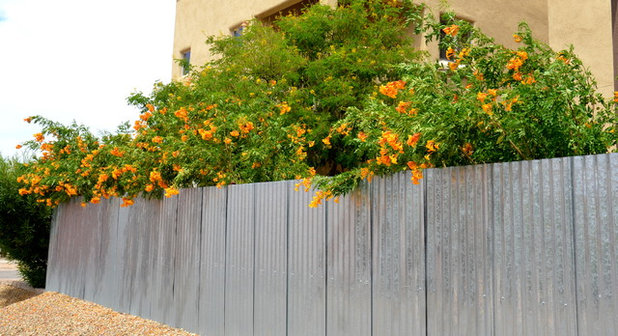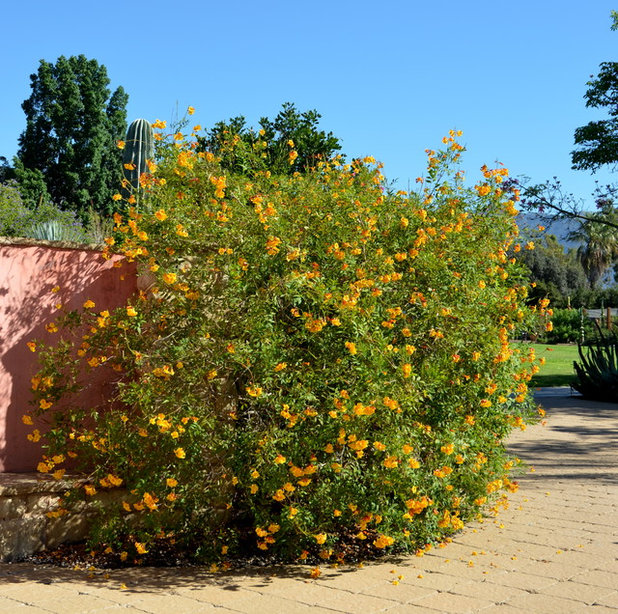Lush, green foliage and orange flowers are just two of the many reasons why people love this Tecoma hybrid. Its large size and rapid growth rate make it a great choice for screening, and lovely orange flowers add welcome color from spring through fall.
Tecoma x ‘Orange Jubilee’ is a popular choice in sunny gardens throughout the southern half of the U.S., where it can be found growing from the Southeast to the arid Southwest.
Caution: While grown throughout the southeastern United States, ‘Orange Jubilee’ can become invasive in areas with hot, humid climates. Use caution when planting, and keep its growth controlled with judicious pruning.

Noelle Johnson Landscape Consulting
Botanical name: Tecoma x ‘Orange Jubilee’
Common names: ‘Orange Jubilee’, orange bells, orange trumpet flower, orange esperanza
Origin: Tecoma stans hybrid
, which is native from Arizona to parts of Texas and south through Mexico and Central America
Where it will grow: Hardy to 10 degrees Fahrenheit, or minus 12.2 degrees Celsius (USDA Zone 8; find your zone)
Water requirement: Low to moderate; water deeply every two weeks in summer (weekly in low-desert zones), every two to three weeks in spring and fall, and monthly in winter
Light requirement: Full, reflected sun or filtered shade
Mature size: 8 to12 feet tall and 8 feet wide
Benefits and tolerances: Moderately drought-tolerant; attracts hummingbirds; deer-resistant
Seasonal interest: Flowers in spring, summer and fall (year-round in frost-free areas)
When to plant: Spring and fall

Noelle Johnson Landscape Consulting
Distinguishing traits. This large shrub’s bright green foliage adds lushness to drought-tolerant landscapes. Serrated leaves are borne along upright branches.
‘Orange Jubilee’ is evergreen in frost-free zones. Frost damage will occur along the outer branches when temperatures dip into the 20s, and it will die back to the ground when temperatures reach the teens. Some people report success growing ‘Orange Jubilee’ in Zone 7 when a layer of mulch is placed over the root zone to protect the roots. Regrowth is quick in spring once the frost-damaged growth has been pruned back.
Got Frost-Damaged Plants? How It Happens, and When and How to Prune

Noelle Johnson Landscape Consulting
Clusters of five or more orange flowers appear spring through fall. Hummingbirds will flock to the 2-inch-long trumpet-shaped flowers.

Noelle Johnson Landscape Consulting
How to use it. The height of ‘Orange Jubilee’ makes it an ideal screening plant, whether planted against a bare fence or used as an informal hedge. Hide an air conditioning unit or pool equipment with a living wall. Plant it off to the side of a window where it will frame your view, or plant it near the corner of a house to soften the edge.
For great color contrast, plant ‘Orange Jubilee’ alongside purple flowering shrubs such as desert ruellia (
Ruellia peninsularis), golden dewdrops (
Duranta erecta), Texas ranger (
Leucophyllum frutescens) or a ground cover like South American mock vervain (
Glandularia pulchella).

Noelle Johnson Landscape Consulting
Planting notes. Plant in well-drained soil. For maximum flowering, plant in full, or even reflected, sun. ‘Orange Jubilee’ is a relatively pest-free shrub. Leaf roller caterpillars can sometimes be a problem, but they are easily treated with the organic pesticide BT
(
Bacillus thuringiensis), which targets only caterpillars.





